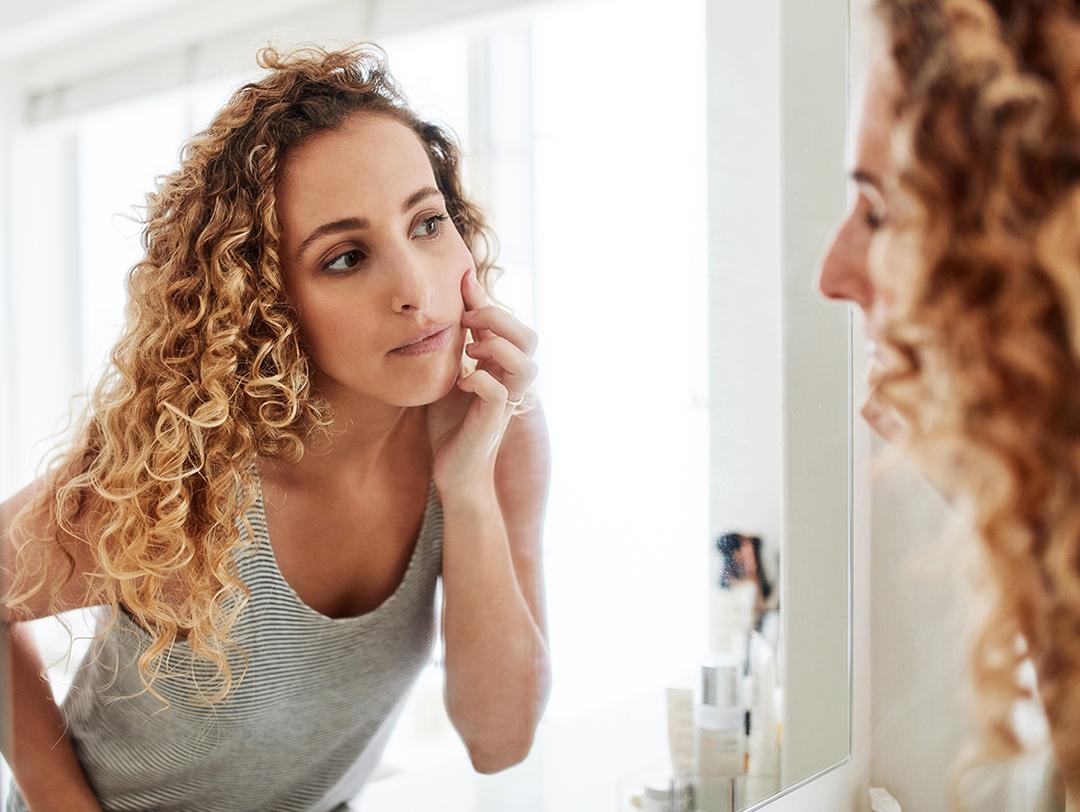10 Pro-Approved Ways to Get Rid of Milia for Good



Runa Bhattacharya


When someone tells you that you have skin like a baby, nine times out of 10, you’d be super flattered. After all, who doesn’t crave smooth, soft skin that's wrinkle-free (except for those cute baby wrinkles!) that newborns are blessed with? But, if you’ve ever noticed those teeny tiny white bumps that sometimes appear on a newborn’s skin, you may notice that you have something in common, besides being super cute, too.
Sometimes called milk spots, they’re called milia, and while they might resemble an acne breakout or whiteheads, milia is actually its own, unique thing—and FYI, adults get them, too (and it's totally normal). “Milia can happen to everyone from adults to babies,” says dermatologist Anthony Rossi, Jr., MD. So if you’ve experienced clusters of these small bumps just under the surface of the skin, especially on your cheeks or around your eyes, don’t stress it. Read on for our complete guide to spotting milia and getting rid of it for good, either on your own or with the help of your dermatologist.


It's about glam time you treated yourself.
MEET THE EXPERT
Anthony Rossi Jr., MD, is a board-certified dermatologist and founder of Dr. Rossi Derm MD. He is recognized internationally as a leading expert on sensitive skin.
Robyn Gmyrek, MD, is a board-certified dermatologist based in New York City.
First, What Is Milia?
“Milia are small cysts that occur when dead skin cells or keratin get clogged under the skin’s surface,” says New York City-based dermatologist Robyn Gmyrek, MD. “In contrast to an acne cyst, they’re not usually red or inflamed, but may become so if irritated.” While milia may resemble small pimples, in reality, the only two things that milia and acne have in common are that they involve clogged pores and that you shouldn’t pick at them. Because milia are much smaller than acne, they typically are much less noticeable, but they do tend to be a lot more stubborn that your average breakouts. In fact, untreated milia can linger on skin for years. And unlike acne, milia usually appear around the eye area or cheeks, though they can sometimes crop up on other areas of your face and your body.
What Is Primary Milia?
Milia can be classified into two categories: primary milia and secondary milia. “Primary milia are considered to arise from birth and some may occur with specific genetic skin conditions Dr. Rossi. Basically your run-of-the-mill milia, in both newborns and adults, fall under the primary category. While primary newborn milia occur in up to 40% of infants and generally resolve on their own in a few weeks, primary adult milia are often the result of using heavy facial creams, think moisturizers and oils in your skincare routine that occlude the skin and end up clogging pores. “As we age, we don’t exfoliate our skin cells as naturally as we did in our younger days,” she says. “Heavy, oil-based creams or ointments weigh down these surface cells, trapping them, and forming milia.”
What Is Secondary Milia?
“A burn, severe rash, or even laser treatment may develop milia,” says Dr. Gmyrek. “As the skin attempts to heal, the pore becomes clogged, leading to trapped dead skin and keratin.” Secondary milia occur when the skin has been traumatized. “They also happen secondary to chronic topical steroid use and can even happen after rashes heal,” Dr. Rossi says.
10 Ways to Get Rid of Milia for Good
1. Don’t touch your skin
Your first line of defense against milia is to leave it alone. What you should not do is pick: You know you shouldn’t pop zits, but let’s be real, many of us do anyway, often with little to no skin damage caused (if we’re lucky). Milia are different because of their hard keratin component. “Without proper, sterile equipment, you can give yourself an infection by introducing germs into the area, or if you’re too aggressive, you can cause a permanent scar,” says Dr. Gmyrek. Repeat after us: Hands off.
2. Use a gentle cleanser
A gentle cleanser will help loosen the roof of dead skin sitting atop the milia you already have (the key to making them disappear, according to Dr. Gmyrek), and prevent new milia from forming. GLOW RECIPE Blueberry Bounce Gentle Cleanser is not only super gentle, but also has a blend of exfoliating acids for an extra milia-busting boost.
3. Use a physical exfoliant
Exfoliation is the most important thing you can do to get rid of milia for good. “[Physical exfoliation] with a facial brush or gentle scrub removes the top dead skin layer and will help milia open and resolve,” says Dr. Gmyrek.
4. Use a chemical exfoliant
“Alpha hydroxy acids like lactic acid or glycolic acid, or beta hydroxy acids such as salicylic acid are helpful to exfoliate the top layer of stratum corneum (made up of dead keratinocytes),” says Dr. Rossi. Don’t get discouraged if it feels like exfoliating isn’t making a difference—it generally takes a week or two to see improvement. Patience is key here. “Do not over-exfoliate,” warns Dr. Gmyrek. “If your skin gets dry or irritated, discontinue exfoliation until your skin is back to normal, then restart using less of the exfoliant, less frequently.”
5. Try manuka honey
If your milia seem red or inflamed (especially if you attempted to pop them), topical manuka honey’s anti-inflammatory and antibacterial properties can help quell the irritation and prevent infection. You can even DIY a face mask with the raw ingredient, if you prefer a more natural approach.
6. Give yourself an at-home steam facial
Steam helps warm up the build up of keratin, making it easier to exfoliate. “The use of warm hydration can loosen up surface skin cells and help them slough away, opening up the milia,” says Dr. Gmyrek. All you need is a bowl of boiling water and a bath towel. After removing the water from the stove, sit with your face several inches away from it with the towel draped over your head, trapping in the steam. Allow the steam to work its magic on your pores for five to ten minutes, then exfoliate immediately afterward for best results.
7. Use rose water
There’s pretty much nothing rose water can’t do when it comes to your complexion. Like manuka honey, its power is derived from its anti-inflammatory properties. Spritz some all over your face several times a day to refresh the skin and keep milia from becoming red and irritated.
8. See your dermatologist for extractions
Got stubborn milia that won’t resolve with home remedies? Just want to put the process on fast-forward? “Acquired milia may continue without treatment. You should see a dermatologist for these. They can help remove them by extracting them or deroofing them,” Dr. Rossi adds. Visiting your dermatologist for milia removal can also be an easy way to quickly (and safely!) extract the milia. “Your doctor will prep the skin with an antibacterial agent, puncture the milia with a sterile needle, and extract the contents—a mix of keratin or dead skin cells—with a special instrument called a comedone extractor,” says Dr. Gmyrek. Your dermatologist can also identify which type of milia you have, which can help it from resurfacing in the future.
9. Get a prescription retinoid
“Topical prescription strength retinoids prescribed by your dermatologist are helpful,” says Dr. Rossi. Retinoids are a common acne treatment thanks to their ability to help exfoliate and unclog the pores. For stubborn milia, your derm may prescribe a retinoid cream or retinol like DIFFERIN Gel to help exfoliate the skin and speed the cell turnover process along. Retinol can make sure your skin extra sensitive to sun exposure, so as always, be sure to be super diligent with sunscreen when using a topical retinoid.
10. Have your derm recommend a skincare routine
One of the main things that causes milia in adults is simply using products that aren’t right for your skin. Getting personalized recommendations for your unique skin type should reduce or get rid of the milia entirely—while bringing more balance to your complexion overall. They’ll also likely recommend a—you guessed it!—sunscreen, which will not only help protect against sun damage, but also may prevent milia from forming in the future.
Want more skincare tips from the pros? Take our Beauty Quiz now to get started. Already an Ipster? Refer your friends to earn points, which you can use toward products. Either way, don’t forget to check us out on Instagram and Twitter @IPSY.
Like this article? Share it with your friends by clicking the icons below!
Liked this post? Share!
Related Stories


Skin
How to Adjust Your Skincare Routine for Mature Skin in the Winter
Published on Dec 4, 2025 • 7 min read


Skin
Meet the Best Moisturizers for Winter, According to Dermatologists
Published on Dec 1, 2025 • 9 min read


Skin
What Is Inflammaging—and Why Everyone’s Talking About It
Published on Dec 1, 2025 • 8 min read


Skin
6 Skincare Trends to Have on Your Radar in 2026, According to Experts
Published on Dec 1, 2025 • 7 min read


Skin
We Grabbed Our Crystal Ball and Found These 6 Skincare Predictions for 2025
Published on Dec 10, 2024 • 7 min read


Skin
Simple Self-Care Tips That Actually Make a Difference
Published on Nov 13, 2025 • 12 min read


Skin
These 9 Face Scrubs Will Unlock Soft and Smooth Skin on Contact
Published on Nov 5, 2025 • 10 min read


Skin
10 Thanksgiving Foods That Will Have Your Skin Coming Back for Seconds
Published on Oct 15, 2025 • 7 min read


Beauty Picked Just for You
Get 5 products worth up to $70
Plus exclusive access to epic deals up to 80% off
Starting at just $14/month. Cancel anytime.